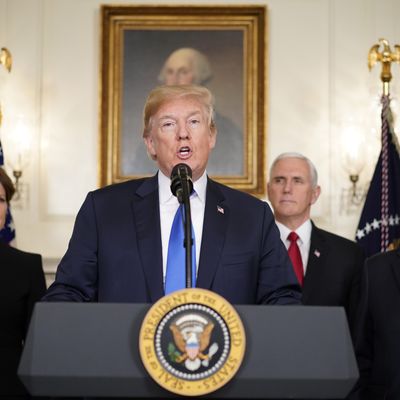
Last week, Donald Trump’s top trade adviser presented him with a plan to make Beijing rue the day that it had decided to steal American intellectual property. The staunchly protectionist U.S. trade representative Robert Lighthizer advised the president to impose tariffs on $30 billion worth of Chinese imports.
Such an aggressive move was bound to provoke retaliation, if not full-blown trade war — as many congressional Republicans were eager to remind the White House. And so, after carefully weighing the pros and cons of the measure, the president told Lighthizer to toss his proposal — and come back with tariffs on $50 billion worth of Chinese imports, instead.
“This has been long in the making,” Trump said Thursday, at a news conference formally announcing the levies. “We’ve lost, over a fairly short period of time, 60,000 factories.”
The president went on to lament the death of American manufacturing; condemn the anti-U.S. trade system propped up by the WTO and NAFTA; and inform the public that the leaders of Japan and the European Union smile sheepishly when he brings up their unfair trade practices, while (presumably) thinking to themselves, “I can’t believe we’ve been able to take advantage of the United States for so long.”
None of this had anything whatsoever to do with the policy the president was there to announce.
The official purpose of the tariffs that Trump unveiled Thursday is not to protect American manufacturing against unfair Chinese competition — but rather, to protect the intellectual property of major U.S. businesses.
For the past seven months, Lighthizer’s office had been investigating allegations that the Chinese government violates American firms’ patent and copyright protections. That probe uncovered evidence that Beijing uses restrictions on foreign ownership of companies within China to coerce American corporations into transferring their technology to its own domestic enterprises. Lighthizer’s report also alleges that China steals trade secrets through cyberattacks, and directs its firms to invest in U.S. companies, so as to gain access to information about strategic technologies and then transfer it to the Chinese government.
The basic charge here — that the Chinese government does not respect other nations’ intellectual property laws — is not terribly controversial. A U.S. International Trade Commission investigation conducted during the Obama years found that IP theft cost American firms nearly $26 billion in 2009, while a study from the U.S. software industry put that figure as high as $60 billion in 2011.
But whether ordinary Americans actually have an interest in policing such theft is less clear. When China violates an American drug company’s software patents, said company’s profit margins (and thus, shareholders’) may take a hit — but American consumers likely benefit from the lower prices on software. And the same holds for other patent-protected products like pharmaceuticals (which Trump has repeatedly argued are far too expensive in the United States).
It makes sense then, that Trump took pains to frame the move as one piece of a broader, protectionist agenda — and made no effort whatsoever to convey the substance of the former.
“This is the first of many,” Trump said as he signed the order. “This is number one — but this is the first of many.”
Specifically, the president promised to establish a “reciprocal” tariff policy — putting an equal and opposite levy on any country that imposes duties on American goods. “We want reciprocal — mirror — some people call it a mirror tariff or a mirror tax,” Trump explained. “If they charge us, we charge them the same thing.”
If we take the president at his word, then this statement augurs a radical transformation of American trade policy — and the beginning of massive, global trade war.
Fortunately, no one takes Trump at his word, least of all on this particular subject. Thus, rather than tanking global markets, Trump’s remarks actually soothed them — apparently many traders had misinterpreted early reports about the tariffs, and thought that the president was proposing a somewhat more robust package than he actually did.
Nonetheless, the move comes with significant downside risks. On Thursday, China’s Ministry of Commerce warned that it is “firmly opposed to the U.S. side’s unilateralism and trade protectionism,” and “will certainly take all necessary measures to resolutely defend its legitimate rights and interests.”
Those measures will include retaliatory tariffs targeting industries in pro-Trump regions of the country, according to The Wall Street Journal.
If China’s response is exactly proportionate — inflicting $50 billion of tariffs on U.S. goods — the macroeconomic impact would be significant but not massive. But matters would become more grave if the trade war escalated from there, as Bloomberg explains:
A simulation by Oxford Economics suggests a 25 percent U.S. tariff on $60 billion worth of Chinese exports, with comparable retaliation, would reduce China’s growth by about 0.1 percentage point this year and a little less next year, chief Asia economist Louis Kuijs in Hong Kong said in a recent note. There would be a slightly smaller impact on the U.S. economy, he said.
“The key risk is that it does not end with this modest baseline scenario,” said Kuijs, who formerly worked for the World Bank in Beijing. “More measures may follow, and tit-for-tat responses could lead to escalation. Collateral damage in other economies will be significant and could further complicate the trade friction.”
There will now be a 30-day comment period before the tariffs take effect. That coming debate is likely to scramble partisan allegiances, as the Chamber of Commerce works to water down the tariffs, and Democrats exploit an opportunity to let their vulnerable incumbents align themselves with Trump – and against the Republican Party: On Thursday, Senate Minority Leader Chuck Schumer said of Trump, “I want to give him a big pat on the back … I’m very pleased that this administration is taking strong action to get a better deal on China.”






























